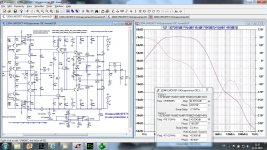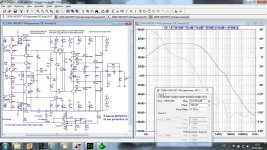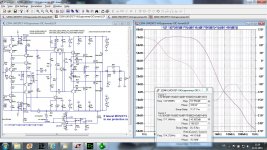Actually, in a rare twist of cheap solutions, the preferred cable turned out to be "zip" (figure 8) power cable or Naim's recommended heavier version of it it. It was still affordable in comparison to typical high-end montrosities. Consider that original purchasers would be accustomed to paying dearly for even basic items so you could anticipate their suspicion of anything without a gilt-edge price.....but it means people are Forced to buy Naim cable, or pay a premium if it's included. Which prevents people from using good ol'e nice price cable....
I'm just wondering, if an amplifier has enough phase margin, say +90 degrees, could a output inductor, or a Zobel, not simply be omitted?
If, besides preventing instability due to RF ingress, the main reason these networks are needed is to prevent the amplifier from becoming unstable due to its phase margin being affected by the L or C at the output then doesn't that automatically mean that if plenty of phase margin is available, then the output inductor, or a Zobel are somewhat superfluos?
If, besides preventing instability due to RF ingress, the main reason these networks are needed is to prevent the amplifier from becoming unstable due to its phase margin being affected by the L or C at the output then doesn't that automatically mean that if plenty of phase margin is available, then the output inductor, or a Zobel are somewhat superfluos?
I don't think so with regard to the Output Zobel.
It is needed to load the amplifier at VHF so that the gain remains similar at all frequencies in the passband.
Regarding the L||R on the output, which helps isolate reactive loads from the NFB loop, then a very large phase margin will allow the amp to remain stable, in that it will not oscillate when a capacitive load is added.
But the stability margins will change and the changed stability margins will change the way the amplifier handles the signal and what the output looks like and sounds like.
Very high phase margin tends to show lower slew on fast signals whereas low phase margin shows very high slew on fast signals.
This show particularly in the "shape" of test squarewaves. Rounded, or overshoot, instead of matching the input wave shape.
I think the consensus is that the output should be a scaled version of the input and not distorted as it passes through the amplifier.
It is needed to load the amplifier at VHF so that the gain remains similar at all frequencies in the passband.
Regarding the L||R on the output, which helps isolate reactive loads from the NFB loop, then a very large phase margin will allow the amp to remain stable, in that it will not oscillate when a capacitive load is added.
But the stability margins will change and the changed stability margins will change the way the amplifier handles the signal and what the output looks like and sounds like.
Very high phase margin tends to show lower slew on fast signals whereas low phase margin shows very high slew on fast signals.
This show particularly in the "shape" of test squarewaves. Rounded, or overshoot, instead of matching the input wave shape.
I think the consensus is that the output should be a scaled version of the input and not distorted as it passes through the amplifier.
I'm just wondering, if an amplifier has enough phase margin, say +90 degrees, could a output inductor, or a Zobel, not simply be omitted?
If, besides preventing instability due to RF ingress, the main reason these networks are needed is to prevent the amplifier from becoming unstable due to its phase margin being affected by the L or C at the output then doesn't that automatically mean that if plenty of phase margin is available, then the output inductor, or a Zobel are somewhat superfluos?
I think the answer is a definitive yes and no
If the global loop phase margin is good, and the high-frequency open-loop output impedance is low, the realistic values of load capacitance may not reduce the phase margin enough to allow instability. Some of this depends on what we think is a reasonable load in the real world. For example, it is a bit hard for me to imagine a situation where the amplifier in a real situation sees way more than 10,000pF, due to speaker cable or anything else. In rough terms, this then hints at how low in frequency the resulting pole might be. However, better to also sim it.
When we SWAG these things, we must keep in mind the fast-decreasing beta of the output transistors at high frequencies within at least a half decade or so of the ULGF. Suppose you have an output Triple with transistors whose beta is 50 and whose ft is 50MHz. Beta starts to roll off at 6dB/octave for each one beginning at 1MHz. Beta for the Triple thus rolls of as the cube of frequency, or 18dB/octave, or 60dB/decade. At 10MHz, Beta cubed is only 125 and a complex number. If the usual Miller-compensated VAS has a resistive 125 ohm output impedance at HF, then the open-loop output impedance of the amp is on the order of 1 ohm, again, complex. 1 ohm against 0.01uF is about 16MHz if I'm right. This all is very rough hand-waiving and the situation is much more complicated than this, but it does help put some things in perspective. Again, SPICE is beautiful in situations like this.
Note also, as discussed before, local stability of the EF output stage is also a concern that must be addressed. Sometimes big base stopper resistors, perhaps on the order of 10 ohms, can help this, but may bring into play other compromises.
Do the compromises that you have to make to be safe without an inductor harm the sound quality as much as a well-implemented inductor? I don't know, but it is a very relevant question.
Cheers,
Bob
It is quite easy to simulate how an amp with exceptional PM of 90degree and GM of 42 dB can became unstable with no inductor, even with quite modest capacitance at the output. Adding small inductor of 0.5 uH parallel with 2.2 ohm put the amp back in safe stable behavior.
first - no cap at the output
second - 53 nF at the output
third - 0.5uH inductor and 53 nF cap at the output
Damir
first - no cap at the output
second - 53 nF at the output
third - 0.5uH inductor and 53 nF cap at the output
Damir
Attachments
I'm just wondering, if an amplifier has enough phase margin, say +90 degrees, could a output inductor, or a Zobel, not simply be omitted?
If, besides preventing instability due to RF ingress, the main reason these networks are needed is to prevent the amplifier from becoming unstable due to its phase margin being affected by the L or C at the output then doesn't that automatically mean that if plenty of phase margin is available, then the output inductor, or a Zobel are somewhat superfluos?
I have been designing amplifiers since 2008 and have never put an inductor on the output. People I have passed my amplifiers on to haven't reported any problems.
Perhaps you are getting confused between capacitance in the speaker and making a stable feedback amplifier.
I can see a capacitive load might make the amplifier unstable if it is designed on the edge of oscillation.
Lucky guy!

What I think is happening is an amplifier is being designed without a speaker connected and tested for stability.
Then when a speaker is connected it is found to be unstable.
So they add an inductor.
The reason the amplifier is unstable is because it wasn't designed with capacitive loads in mind (a speaker).
I have seen the same problem with some of my early designs. I made the speaker as wide band as possible then when I connected a speaker it oscillated badly. However I didn't add an inductor I reworked the VAS capacitor to stop the oscillation.
With MOSFET amplifiers it is also important not to have too low a gate resistor value.
What I think is happening is an amplifier is being designed without a speaker connected and tested for stability.
Then when a speaker is connected it is found to be unstable.
So they add an inductor.
The reason the amplifier is unstable is because it wasn't designed with capacitive loads in mind (a speaker).
I have seen the same problem with some of my early designs. I made the speaker as wide band as possible then when I connected a speaker it oscillated badly. However I didn't add an inductor I reworked the VAS capacitor to stop the oscillation.
With MOSFET amplifiers it is also important not to have too low a gate resistor value.
Hi Nigel,
1) When you test for stability you use dummy loads that represent speakers as well as using extreme and varied loads.
A lot of high performance amps will need an inductor as they will have most likely sacriced unconditional stability for performance.
My latest prototype has been informally tested without an inductor on several different speakers will several random cable setups. It didn't appear to struggle but who knows never had the chance to run sine and square waves sthrough it. It has 82 degrees of PM btw (simulated of course
2) You probably kept making the miller cap bigger until you got stability. So you were sacrificing performance all the way. Or you could have added the inductor?
3) Low MOSFET gate resistors are very disireable. The faster you can charge / discharge the gate the faster the OPS. The faster the OPS the less it degrades amplifier stability (PM/GM). I have run 22R gate resistors on IRFP240/9240s. Others have run less. Control the parasitics and you can use low gate resistors.
Paul
Last edited:
Hi Nigel,
1) When you test for stability you use dummy loads that represent speakers as well as using extreme and varied loads.
A lot of high performance amps will need an inductor as they will have most likely sacriced unconditional stability for performance.
My latest prototype has been informally tested without an inductor on several different speakers will several random cable setups. It didn't appear to struggle but who knows never had the chance to run sine and square waves sthrough it. It has 82 degrees of PM btw (simulated of course). Still going to add the inductor though. Make your own luck...?
2) You probably kept making the miller cap bigger until you got stability. So you were sacrificing performance all the way. Or you could have added the inductor?
3) Low MOSFET gate resistors are very disireable. The faster you can charge / discharge the gate the faster the OPS. The faster the OPS the less it degrades amplifier stability (PM/GM). I have run 22R gate resistors on IRFP240/9240s. Others have run less. Control the parasitics and you can use low gate resistors.
Paul
2/ I still had adequate frequency response after stabilising the amplifier.
3/ I use 390R on mosfet gates to stop the gate C and inductance of the track making an oscillator.
2/ I still had adequate frequency response after stabilising the amplifier.
As long as the amplifier does what it was designed to do then all is good...
3/ I use 390R on mosfet gates to stop the gate C and inductance of the track making an oscillator.
If you can't control the parasitics then you have to swamp them.
- Status
- This old topic is closed. If you want to reopen this topic, contact a moderator using the "Report Post" button.
- Home
- Amplifiers
- Solid State
- Output inductor in power amps - pro and con


